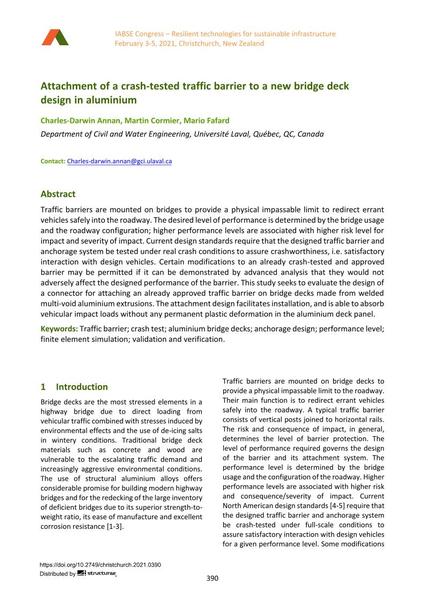Attachment of a crash-tested traffic barrier to a new bridge deck design in aluminium

|
|
|||||||||||
Détails bibliographiques
| Auteur(s): |
Charles-Darwin Annan
(Department of Civil and Water Engineering, Université Laval, Québec, QC, Canada)
Martin Cormier (Department of Civil and Water Engineering, Université Laval, Québec, QC, Canada) Mario Fafard (Department of Civil and Water Engineering, Université Laval, Québec, QC, Canada) |
||||
|---|---|---|---|---|---|
| Médium: | papier de conférence | ||||
| Langue(s): | anglais | ||||
| Conférence: | IABSE Congress: Resilient technologies for sustainable infrastructure, Christchurch, New Zealand, 3-5 February 2021 | ||||
| Publié dans: | IABSE Congress Christchurch 2020 | ||||
|
|||||
| Page(s): | 390-395 | ||||
| Nombre total de pages (du PDF): | 6 | ||||
| DOI: | 10.2749/christchurch.2021.0390 | ||||
| Abstrait: |
Traffic barriers are mounted on bridges to provide a physical impassable limit to redirect errant vehicles safely into the roadway. The desired level of performance is determined by the bridge usage and the roadway configuration; higher performance levels are associated with higher risk level for impact and severity of impact. Current design standards require that the designed traffic barrier and anchorage system be tested under real crash conditions to assure crashworthiness, i.e. satisfactory interaction with design vehicles. Certain modifications to an already crash-tested and approved barrier may be permitted if it can be demonstrated by advanced analysis that they would not adversely affect the designed performance of the barrier. This study seeks to evaluate the design of a connector for attaching an already approved traffic barrier on bridge decks made from welded multi-void aluminium extrusions. The attachment design facilitates installation, and is able to absorb vehicular impact loads without any permanent plastic deformation in the aluminium deck panel. |
||||
